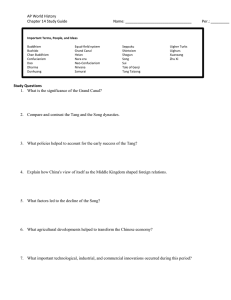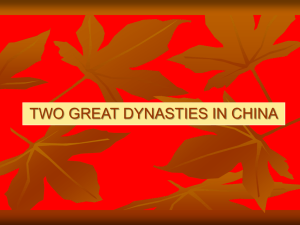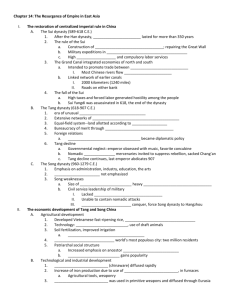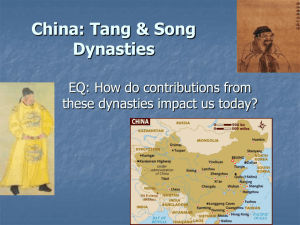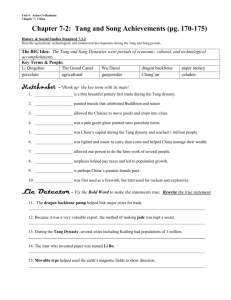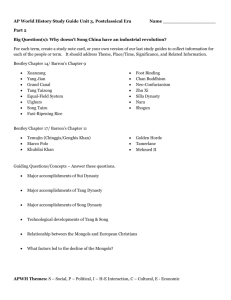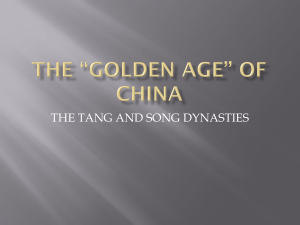Name: __________________________ Date: ______________ Period: ______ Chapter 12.1 Reading Quiz
advertisement
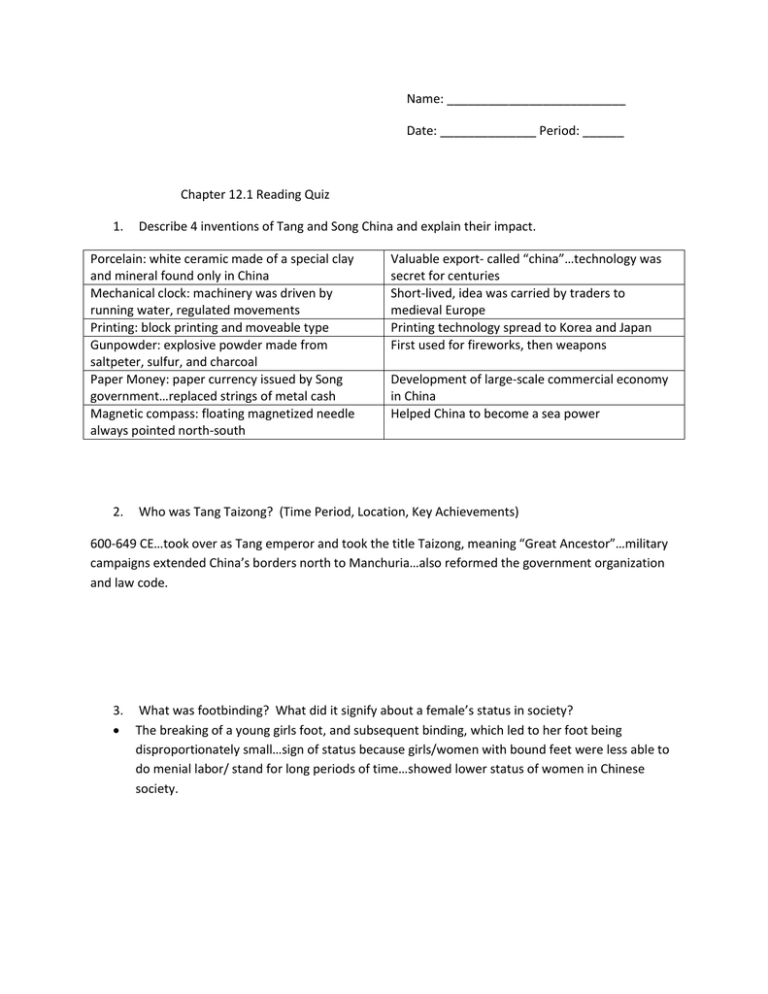
Name: __________________________ Date: ______________ Period: ______ Chapter 12.1 Reading Quiz 1. Describe 4 inventions of Tang and Song China and explain their impact. Porcelain: white ceramic made of a special clay and mineral found only in China Mechanical clock: machinery was driven by running water, regulated movements Printing: block printing and moveable type Gunpowder: explosive powder made from saltpeter, sulfur, and charcoal Paper Money: paper currency issued by Song government…replaced strings of metal cash Magnetic compass: floating magnetized needle always pointed north-south 2. Valuable export- called “china”…technology was secret for centuries Short-lived, idea was carried by traders to medieval Europe Printing technology spread to Korea and Japan First used for fireworks, then weapons Development of large-scale commercial economy in China Helped China to become a sea power Who was Tang Taizong? (Time Period, Location, Key Achievements) 600-649 CE…took over as Tang emperor and took the title Taizong, meaning “Great Ancestor”…military campaigns extended China’s borders north to Manchuria…also reformed the government organization and law code. 3. What was footbinding? What did it signify about a female’s status in society? The breaking of a young girls foot, and subsequent binding, which led to her foot being disproportionately small…sign of status because girls/women with bound feet were less able to do menial labor/ stand for long periods of time…showed lower status of women in Chinese society. Chapter 12.1: Two Great Dynasties in China I. The Tang Dynasty Expands China Sui Wendi declared himself the first emperor of the Sui Dynasty…lasted through only 2 emperors from 589 to 618 Greatest accomplishment was completion of the Grand Canal o Waterway connected the Huang He (Yellow River ) and the Yangtze River o Vital trade route between the northern cities and the southern rice-producing region o 1,000 mile waterway…tens of thousands of peasant men and women toiled…1/2 died o Thousands more died rebuilding the Great Wall o People turned against the Sui Dynasty…overworked and overtaxed 618: member of the imperial court strangled the 2nd Sui emperor A. Tang Rulers Create a Powerful Empire Tang Dynasty- lasted for nearly 300 years (618-907) o Begun by emperor Tang Taizong (627-649) Empire expanded Taizong’s armies reconquered the northern and western lands that had been lost after the Han 668- China extended influence over Korea Empress Wu Zhao- held real power from about 660 on…690, Empress Wu assumed title of emperor for herself- only woman to do that in China Tang rulers further strengthened the central government of China Expanded the network of roads and canals Promoted foreign trade and improvements in agriculture Tang China prospered B. Scholar-Officials Tang rulers needed to restore China’s vast bureaucracy Tang rulers revived and expanded the Civil service system to recruit good officials Opened schools around the country to train young scholars in Confucianism, poetry Elites: scholar-officials Exams technically open to all men, but needed expensive years of schooling to do well Eventually, talent and education became more important than noble birth in winning power…many moderately wealthy families shared in China’s government C. The Tang Lose Power By the mid-700’s Tang Dynasty was weakening…to pay for military expansion, Tang rulers reimposed crushing taxes Times of famine…bandit gangs Tang could not control the vast empire that they had built Battle of Talas: 751, Arab armies defeated the Chinese…Central Asia passed out of Chinese control II. III. A. B. C. 907 Chinese rebels sacked and burned the Tang capital at Chang’an…and murdered the last Tang emperor (a child). The Song Dynasty Restores China After the end of the Tang Dynasty, rival warlords divided China into separate kingdoms 960: able general reunited china and proclaimed himself Song Taizu, first Song emperor Song Dynasty lasted 3 centuries (960-1279) Song ruled a smaller empire than the Han or Tang, but China remained stable, powerful, and prosperous Song armies never regained the western lands lost after 751…or the northern lands Song paid annual tributes of silver, silk, and tea to northern enemies (ex: Jurchens) Early 1100’s, Jurchens (Manchuria) conquered northern China and established the Jin empire…forced the Song to retreat south across the Huang He After 1126: Song Emperors ruled only southern China New capital at Hangzhou…(coastal city, south of Yangtze) Southern Song Dynasty (1127-1279) had rapid economic growth o South as economic heartland An Era of Prosperity and Innovation Period of Tang and Song dynasties- intense growth China’s population nearly doubled to 100 million China was the most populous country in the world, and most advanced Science and Technology Important inventions: movable type and gunpowder Movable type: printer could arrange blocks of individual characters in a frame to make up a page for printing Gunpowder: led to explosive weapons Porcelain Mechanical clock Paper money Use of magnetic compass for navigation Chinese developed algebra and used zero…also use of negative numbers Agriculture Rapid growth of China resulted from advances in farming Improvement in cultivation of rice 1000- imported “quick-rice” from Vietnam o Harvest 2 rice crops each year o Chinese officials distributed seedlings throughout the country o China able to produce more food to feed a growing population Trade and Foreign Contacts Foreign trade flourished under the Tang and Song Tang imperial armies guarded the Silk Roads D. IV. A. B. China lost control over routes during Tang decline…Chinese merchants then relied increasingly on ocean trade o Advances in sailing technology: use of magnetic compass o During Song period: China developed into greatest sea power in the world International trade Merchant ships carried trade goods to Korea and Japan Sailed across Indian Ocean to India, Persian Gulf, and coast of Africa Chinese merchants established trading colonies around Southeast Asia Chinese culture spread through East Asia o Major cultural export- Buddhism o Buddhism spread from China, Japan, Korea, and Vietnam Tang- tea arrived in China from Southeast Asia- Chinese become avid tea drinkers and tea producers. Foreign religions, including Islam and some Eastern sects of Christianity, also spread to China A Golden Age of Art Prosperity of Tang and Song nourished an age of artistic brilliance Scholar-officials- expected to write poetry and to own at least one fine painting Tang period produced great poetry o Li Bo- life’s pleasures o Du Fu- praised orderliness and Confucian virtues…wrote critically about war Chinese painting reached new heights of beauty during the Song Dynasty…shows Daoist influence o Beauty of natural landscapes…muted colors…black ink was favorite paint o “Black is ten colors” Changes in Chinese Society Chinese society became increasingly mobile People moved to the cities in increasing numbers More opportunities in cities for managers, professionals, and skilled workers Civil Service Exam was the most important avenue for social advancement Levels of Society Power of old aristocratic families faded New, much larger upper class emerged…scholar-officials and their families Gentry: powerful, well-to-do people o Gentry attained their status through education and civil service positions, rather than land ownership Urban middle class- merchants, shopkeepers, skilled artisans, minor officials, and others Bottom of urban society: laborers, soldiers, and servants Largest class= peasants The Status of Women Women always subservient to men in Chinese Society Women’s status further declined during Tang and Song periods o Especially upper class women Foot-binding for upper-class girls o Continued into 20th century o Young girls feet- arches were broken, curled all but the big toe under “lily-foot” o Women with bound feet were crippled for life o Sign of status and of not able to do menial labor
